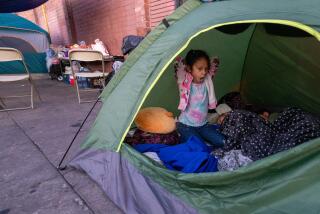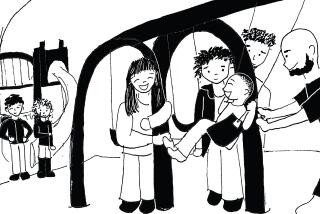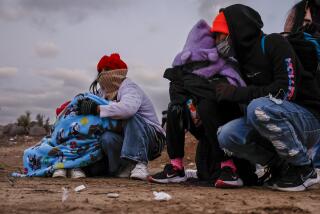On the Ground: Denmark’s winter of refugees
They arrived in early November, 120 of them. A post on my daughter’s school website announced they would be housed in the vandrerhjem, the travelers’ hostel, across the street from the school.
We walked down to take a look. The temperature was near zero, and bundled in scarves and hats and gloves, we wondered how it was for the new arrivals, having trekked so far by sea and by land only to face a long Scandinavian winter. Asylum seekers, most from Syria, they had been relocated to Bornholm, an island 200-odd miles east of the Danish mainland — a summer paradise that turns bleak and deserted in winter, as we, recent arrivals ourselves, were discovering.
At the hostel, we found a few kids kicking a ball around in the asphalt turnaround. Two women in hijabs passed with mounds of bedding in their arms. A young guy in jeans and a hooded sweatshirt jabbed at a phone. A Danish woman explained in English to a black-garbed woman where the washing machines were. We felt we were intruding. As we turned to leave, a round-faced boy of seven or eight called out to us “Hi!” Or maybe he was trying the Danish greeting “Hej.”
My daughter, 12 now, had grown up mostly in Mexico with her Danish mother, Karen, and me, her American father. She’d never seen snow. We’d wanted her to have a year in a Danish school. So far it wasn’t going all that well. Aviaya had yet to make friends and missed Mexico. It was miserably cold. Some days, we felt displaced here ourselves.
There had been little else in the news lately but the refugee situation. The conservative Danish coalition in power was taking a hard line. Denmark, historically liberal and welcoming, had placed advertisements in newspapers in Lebanon and Jordan warning refugees not to come. Now under pressure from the other European governments, this small, wealthy country had agreed to admit several thousand asylum seekers. Many had crossed north Germany by foot to the Danish border, hoping to make it to Sweden. Some Danes, in open defiance of their government, had spirited them across Denmark in their cars. Meanwhile thousands more refugees were pouring into Greece.
In the days following, we passed our new neighbors on the streets: families, youths, couples, elders. The men returned our greetings, the women not always. On buses the refugees sometimes chatted loudly, earning severe glances from Danish matrons clutching their shopping bags. So many unspoken rules of behavior in a new land. We imagined the refugees came from places more like our Mexico: crowded, animated, unruly.
One afternoon that first week I went to meet Aviaya at the after-school recreation center. The boy who had greeted us at the hostel was there, playing a video game. His name was Abdel. He and a few other refugee boys had discovered the school playground, then the cornucopia of computers, food and art materials at the rec center. At first the teachers had resisted the incursion, but Abdel, ingratiating and bright, had won them over.
Aviaya came home with a notice calling for volunteers to help collect money for the refugees. On Saturday morning, we canvassed the neighborhood, door to door. Most answered, and all who did responded with donations.
A day later a taxi driver said to Karen, “You’ll see. This will end in hatred.”
::
The following week, the fifth-grade class at the school proposed a potluck dinner to welcome their new neighbors at the hostel. The entire village was invited.
Winter deepened. The television news told of incidents and reprisals across Europe: the Paris attacks, right-wing gangs, besieged liberal politicians. In Denmark, a new law would allow police to confiscate refugees’ cash and valuables to pay for their accommodation, along with other harsh measures.
We passed our new neighbors on the streets: families, youths, couples, elders. The men returned our greetings, the women not always.
Some Danes seemed naive to me about these matters. I come from a country of constant ethnic jostling. Here, when you say somebody is Danish, it is understood to mean ethnic Danish exclusively. When you say someone is American, that person could be of any ethnicity. I never thought of this as an achievement but now I do. Some here insist that Muslims are different from other immigrants, they can’t and won’t integrate. Yet Muslims have been coming to Denmark for several generations, and I see their children on television as newscasters, writers, academics.
I decided to make a lentil soup as our contribution to the potluck dinner. I thought a Middle East staple might provide a warm, not unfamiliar offering on a cold night.
That last Saturday in November, we walked two caldrons of soup to the school and set them down with other food on a long table in a classroom hallway. The refugee women, allotted money to shop for ingredients, had made the most of it: baba ghanouj, hummus, baklava. These ladies could cook! The Danes brought mostly pasta and salads, breads and cakes.
We sat at a table with three women with head scarves. One was a lawyer from Aleppo who had fled the bombing with her daughter and grandson. Her husband had stayed behind. Another, an Iraqi she had met on the journey, had brought her son. We chatted warmly, employing a little common English. They were as curious as to what had brought us here as we were about their perilous odyssey.
After dinner, as we all stood by the food table posing for photos, I noticed the lentil soup sat almost untouched. Then I realized there were paper plates but no bowls. Or was it my soup?
No matter. We bore the caldrons home and ate it ourselves.
::
January. Our cheeks sting from icy Baltic winds. Karen, a writer and translator, is teaching Danish to immigrants who already have been granted asylum: Syrians, a Russian, young Eritrean men with frightening stories of crossing the Libyan desert for days without food. Those clever at languages will find their way more readily, while for others it will be tough.
Abdel and his friends no longer come to the school to play. The hostel children are bused to a school on the other side of the island now. Aviaya has seen snow. She is doing better but still has trouble with math. Meanwhile, she has taken an intense interest in the news.
An Islamist couple has killed 14 people and injured 22 in my home state, California. On New Year’s Eve in Cologne, a crowd of young North African men molested ethnic German girls. Across Europe, the mood darkens. Now a new fear is voiced, that among the refugees are Islamic State infiltrators, plants. I recall the faces of our new neighbors at the school dinner, in the street and in the market, and wonder if an Islamic State mole lurks among them.
::
Early March, and it is still cold, though first blooms and cooing doves tease us with signs of spring. The Danes who drove the asylum-seekers across Denmark to the Swedish border have been charged and are being brought to court. Yesterday Karen and Aviaya saw refugees from the hostel, people we know, in the nearby town, buying suitcases at a thrift store. They’ll be leaving the first of April, we’ve heard.
We’ve passed a hard winter together. We’ll miss the words and smiles exchanged, the baba ghanouj. Maybe they’ll miss us a little. Some will be permitted to make a new life here on the island or elsewhere in Denmark.
What of the others, those who don’t receive asylum? More than 4 million people have fled Syria, millions more are internally displaced. Aleppo lies in ruins. Will the lawyer and her children reunite with their father, if he is alive? How long before people can go back and begin to rebuild war-razed cities, towns, villages? Years? Decades?
They can’t go on but they will, piecing together hope in a world shattered by division.
Tony Cohan is the author of the memoirs “On Mexican Time” and “Native State,” and the upcoming novel “The Night Fishers.”
Follow the Opinion section on Twitter @latimesopinion and Facebook
More to Read
A cure for the common opinion
Get thought-provoking perspectives with our weekly newsletter.
You may occasionally receive promotional content from the Los Angeles Times.






